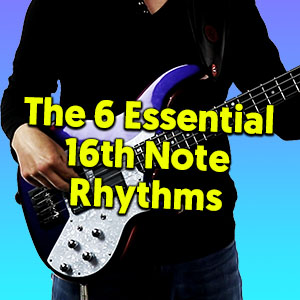In this lesson we look at how you can use a different method for counting 16th notes while playing funky riffs. This especially works for rhythms based on implied polyrhythmic groupings of 3
What Are Polyrhythms?
Polyrhythms occur when more than one type of rhythm is played at the same time. If you try to break a polyrhythm down by counting the subdivisions of the original time signature, it will be like trying to fit a square peg into a round
hole. Instead, the second rhythm needs to be broken down and analysed to see where the groupings are. Today, we are going to break down a popular funk groove in order to see the polyrhythm and use it to feel where the main accents lie.
The riff we are going to use is in the key of D major and is based around a D7 chord.
D F# A C
1 3 5 b7
The line also makes good use of chromatic notes by using them to walk back to the root.

Steps To Working Out The Polyrhythm
- Subdivide the rhythm and pick out the accents
(1) e + (a) 2 e (+) a
- Substitute ‘1e+a’ for numbers
(1) 2 3 (4) 1 2 (3) 4
- Group numbers into threes instead of fours
(1) 2 3 (1) 2 3 (1) 2
Now you should have a better understanding of how the first half of bar 1 sounds as you no longer need to place accents on unusual beats. Instead, you can simply count in groups of twos and threes so the accent always lands on the 1.













Mark this is nice , thanks.
Love it…
Great lesson!
gradually,am pick up….great lessons
Hey Mark, this is really helpful. 16th note syncopation is easier to get this way. Great lesson!
Great Lesson !
Hi Mark,
Did you ever heard an Indian technic called Takadimi? It uses sound words that are easy to pronounce fast. For example a triplet is said: TaKiTa; four sixteens are pronounce as TaKaDiMi and for each rhydm they have a Different word. Could you make a video about that? I am a premium member. Thanks for the great videos
Carlos Becerra, I do not know if you’ll ever see this, but thank you. You are truly a genius.